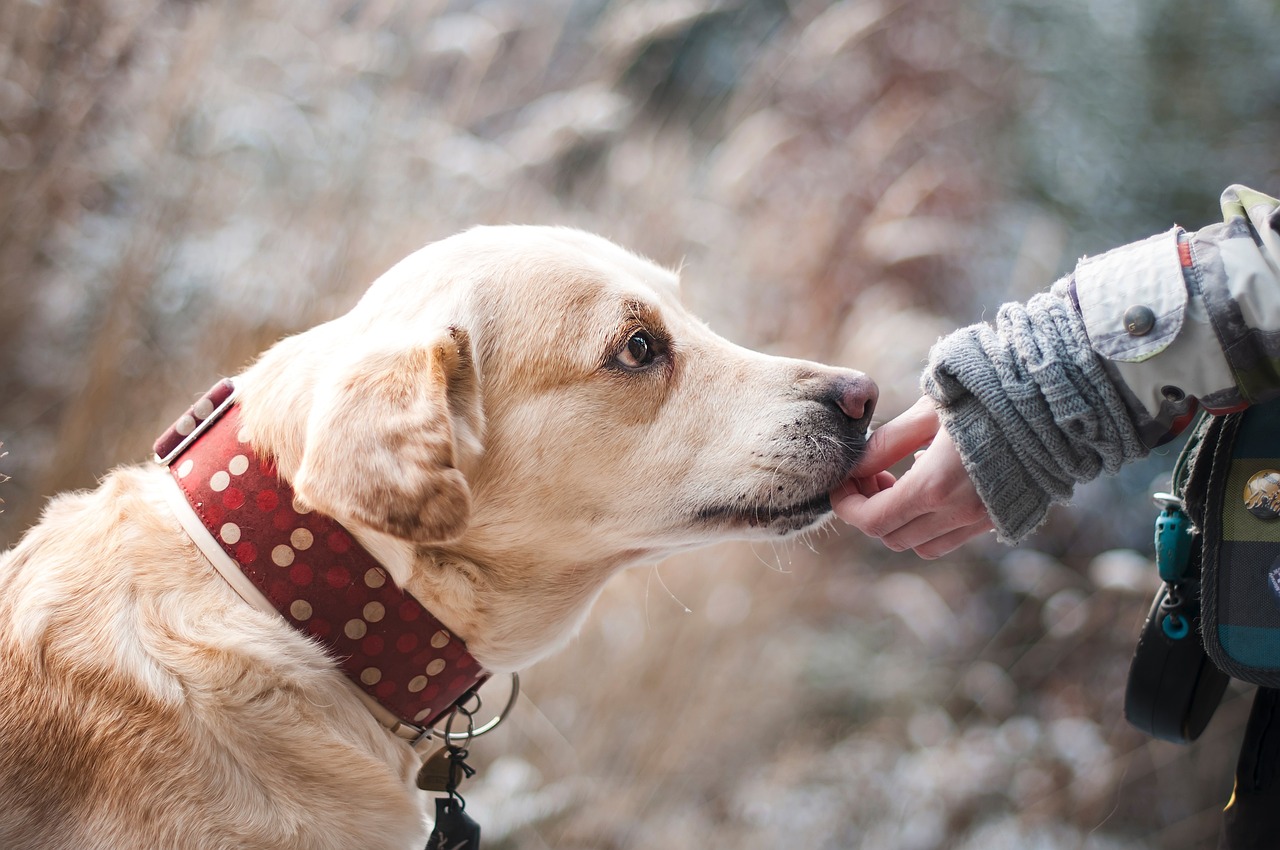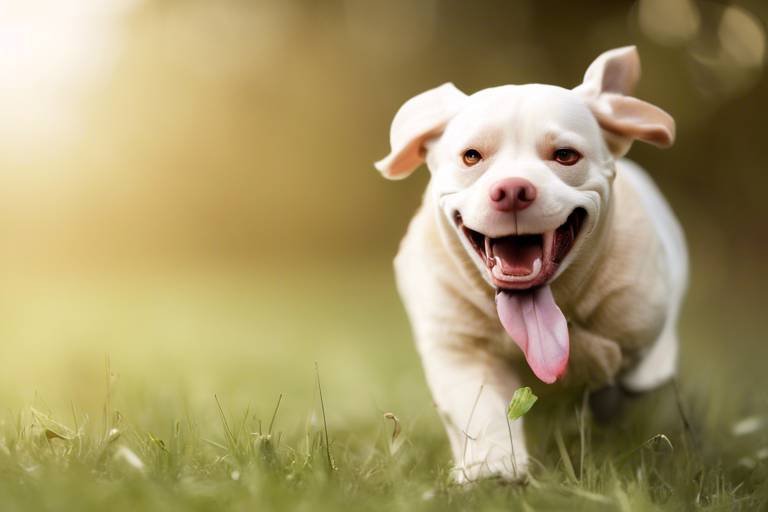How to Recognize Signs of Aggression in Pets
Have you ever noticed your furry friend acting a bit off? Perhaps they’ve suddenly become more defensive or irritable. Understanding the signs of aggression in pets is crucial for any responsible pet owner. Not only can recognizing these signs help keep you and your family safe, but it can also lead to a more harmonious relationship with your beloved animal. Just like humans, pets have their own ways of expressing discomfort, fear, or aggression, and being able to identify these signals can make all the difference. In this article, we will explore various signs of aggression in pets, helping you to identify and address potential behavioral issues effectively.
Aggression in pets is not just a random outburst; it's often a response to specific stimuli or situations. Understanding the underlying causes of this behavior is crucial for effective intervention. Pets may display aggression due to fear, territorial instincts, or even pain. Just like a person who feels cornered might lash out, pets can exhibit similar reactions when they feel threatened. Recognizing that aggression is usually a symptom of something deeper is the first step in addressing it. By becoming familiar with the various forms of aggression, you can better prepare yourself to handle these situations when they arise.
Recognizing the common signs of aggression in pets is essential for their well-being and your safety. These signs often manifest through various behaviors that indicate a pet may be feeling threatened or aggressive. For instance, a dog that suddenly growls when approached or a cat that hisses when someone enters its space are clear indicators that something is amiss. Being aware of these behaviors can help you intervene before a situation escalates. Here are some typical behaviors to watch for:
Body language plays a significant role in interpreting a pet's emotional state. Just like humans, pets communicate a lot through their posture and movements. For example, a dog that stands tall with a stiff body might be feeling confrontational, while a cat that crouches with its tail tucked can indicate fear. Understanding these signals can help you gauge whether your pet is feeling aggressive or just a bit anxious. Some specific indicators include:
A pet's tail position can reveal a lot about their mood. A raised tail often signifies confidence or excitement, while a lowered tail can indicate submission or fear. On the other hand, a tail that is held horizontally or is stiff can be a warning sign of aggression. It's essential to observe these tail movements closely, as they can offer immediate insight into your pet's emotional state.
The position of a pet's ears and the intensity of their gaze can also indicate aggression. Ears that are pinned back against the head often signal fear or aggression, while ears that are perked up may indicate curiosity or alertness. Additionally, a hard stare or dilated pupils can be a clear warning that a pet is feeling threatened. Learning to interpret these visual cues effectively can help you respond appropriately to your pet's needs.
Pets often use vocalizations to communicate their feelings, and understanding these sounds can be vital for recognizing aggression. For instance, a growl is a clear warning that a pet is uncomfortable and may feel the need to defend itself. Similarly, a high-pitched yelp can indicate pain or fear, while incessant barking may signal anxiety or territorial behavior. Paying attention to these vocalizations can provide important context to your pet's behavior.
Identifying triggers that lead to aggressive behavior is vital for prevention. Common situations or stimuli that can provoke aggression in pets include loud noises, unfamiliar people, or sudden movements. For instance, a dog may react aggressively to a stranger approaching its owner, while a cat might hiss at a vacuum cleaner. By understanding these triggers, you can work to minimize your pet's exposure to them and create a safer environment.
Fear and anxiety are significant contributors to pet aggression. A scared pet may lash out as a defense mechanism, much like a cornered animal. Understanding how these emotions manifest can help owners manage and mitigate aggressive behaviors. If a pet is showing signs of fear, it’s crucial to address the root cause rather than just the aggressive behavior.
Territorial instincts can lead to aggression, especially in pets. Dogs, for example, may bark at passersby to protect their home, while cats may become aggressive if they feel their space is being invaded. Recognizing these territorial behaviors and developing strategies to manage them effectively is essential for maintaining peace in your home.
Preventive measures can significantly reduce the likelihood of aggression in pets. Creating a calm and secure environment is key to helping your pet feel safe and less prone to aggression. Simple changes in your pet’s routine or environment can lead to a more relaxed demeanor.
Proper socialization is key to preventing aggression. Exposing pets to various environments, people, and other animals in a controlled manner can help them feel more comfortable and confident. This exposure can prevent fear-based aggression from developing later on.
Training plays a crucial role in managing aggression. Techniques such as positive reinforcement can help teach pets appropriate behaviors and responses. Discovering various training methods and behavior modification techniques can greatly assist in reducing aggressive tendencies in pets, allowing for a more harmonious relationship between you and your furry friend.
- What should I do if my pet shows signs of aggression?
It's essential to consult a veterinarian or a professional animal behaviorist for guidance. - Can aggression in pets be trained out?
Yes, with proper training and socialization, many aggressive behaviors can be modified. - Are certain breeds more prone to aggression?
While some breeds may have a reputation for aggression, individual temperament and training play a significant role.

Understanding Pet Aggression
Pet aggression can be a perplexing and concerning issue for many pet owners. It's crucial to understand that aggression is not merely a behavioral flaw; rather, it is often a response to specific stimuli or situations that trigger an emotional reaction. Just like humans, pets experience a range of emotions, and aggression can stem from feelings of fear, anxiety, or even excitement. By recognizing the underlying causes of aggression, pet owners can take proactive steps to address these behaviors and foster a more harmonious living environment.
One of the first things to consider is that aggression can manifest differently depending on the type of pet. For instance, dogs may exhibit aggressive behaviors through barking, growling, or lunging, while cats might show aggression through hissing, swatting, or even biting. Understanding these differences is essential for effective management. It's also important to note that aggression can be categorized into several types, including reactive aggression, which occurs in response to a perceived threat, and proactive aggression, where a pet may display aggression to gain resources or territory.
To better understand pet aggression, it can be helpful to break down the contributing factors. These factors can be broadly categorized into internal and external triggers:
- Internal triggers: These include a pet's genetic predisposition, past experiences, and individual temperament.
- External triggers: These can be environmental factors such as loud noises, unfamiliar people or animals, and changes in routine.
Addressing pet aggression requires a multi-faceted approach. Owners must be observant and attentive to their pets' behavior, as well as the circumstances surrounding aggressive incidents. Keeping a journal of aggressive behaviors can help identify patterns and triggers, allowing for more effective intervention strategies. Moreover, working with a professional animal behaviorist or trainer can provide valuable insights and techniques tailored to the specific needs of the pet.
Ultimately, understanding pet aggression is about empathy and awareness. By taking the time to learn about the emotional states of our furry companions, we can create a safer and more loving environment for everyone involved. Recognizing the signs of aggression and understanding their roots not only enhances the bond between pets and their owners but also contributes to the overall well-being of both parties.

Common Signs of Aggression
Recognizing the common signs of aggression in pets is essential for any responsible pet owner. Just like humans, pets can experience a range of emotions, and sometimes those emotions can bubble over into aggression. It's crucial to be vigilant and observant because early detection can prevent potential incidents. So, what should you be on the lookout for? Let's dive into some telltale signs that your furry friend might be feeling a bit feisty.
One of the most obvious indicators of aggression is a change in body language. For instance, if your pet suddenly becomes stiff or rigid, this can be a signal that they are on high alert or feeling threatened. Another common behavior is growling or barking, which can serve as a vocal warning to others. But don't just focus on sounds; pay attention to their facial expressions as well. A pet that shows its teeth or has a fixed stare is likely feeling aggressive.
Moreover, posturing plays a significant role in understanding aggression. Dogs, for instance, may stand tall with their ears perked up, while cats might puff up their fur to appear larger. Both are ways of signaling that they are not to be messed with. If you notice your pet exhibiting such behaviors, it's essential to give them space and avoid provoking them further.
Another important aspect to consider is the context in which these signs appear. For example, if your dog is growling while a stranger approaches, it could be a protective instinct kicking in. On the other hand, if your cat hisses when you try to pick them up after they've been sleeping, it might just be a sign of annoyance rather than aggression. Understanding the context can help you discern whether the behavior is a normal reaction or something that needs addressing.
In addition to body language and vocalizations, there are also environmental triggers that can lead to aggressive behavior. For example, if your pet feels cornered or threatened by another animal, their instinct may be to lash out as a defense mechanism. This is particularly common in multi-pet households where competition for resources like food and attention can create tension. Always observe how your pets interact with each other and with their surroundings; this can provide valuable insights into their emotional state.
In conclusion, being aware of the common signs of aggression in pets is not just about preventing bites or scratches; it's about fostering a harmonious environment for both pets and humans. By paying attention to body language, vocalizations, and environmental factors, you can better understand your pet's needs and feelings. This proactive approach not only enhances your relationship with your pet but also creates a safer space for everyone involved.
- What should I do if I notice signs of aggression in my pet? It's essential to give your pet space and avoid any actions that may provoke them further. Consulting a veterinarian or a professional animal behaviorist can also provide guidance tailored to your pet's specific situation.
- Are certain breeds more prone to aggression? While some breeds may have tendencies toward aggressive behavior, it largely depends on the individual animal's upbringing, socialization, and environment.
- Can aggression be trained out of a pet? Yes, with proper training and behavior modification techniques, many pets can learn to manage their aggressive tendencies. Consistency and patience are key!
Body Language Indicators
Understanding a pet's body language is like deciphering a secret code. Pets, much like humans, express their feelings and emotions through their posture and movements. If you can tune into these signals, you can better understand what your furry friend is trying to communicate. For instance, a dog that is feeling aggressive may display certain physical characteristics that can serve as red flags for pet owners. Recognizing these indicators can help in preventing potential confrontations and ensuring a safe environment for both pets and humans.
One of the most telling signs of aggression is the position of a pet's tail. A raised tail can indicate excitement or confidence, but when it is held high and stiff, it may suggest that the pet is feeling threatened or aggressive. Conversely, a lowered tail often signals fear or submission. It’s essential to pay attention to the nuances of tail movement; for example, a tail that is wagging rapidly might seem friendly, but if it’s accompanied by a stiff posture, it could indicate agitation.
Similarly, the position of a pet's ears can provide valuable insight into their emotional state. Ears that are pulled back against the head often signify fear or submission, while ears that are erect and forward may indicate alertness or aggression. When you observe a pet's eyes, look for intensity in their gaze. A pet that is staring intently at another animal or person may be preparing to act aggressively, especially if their pupils are dilated. Understanding these visual cues can help you gauge the level of aggression in your pet and take appropriate action.
In addition to tail and ear positions, other body language indicators can include:
- Body posture: A pet that stands tall with a stiff body may be feeling aggressive, while a crouched position often indicates fear.
- Facial expressions: Growling, baring teeth, or a wrinkled muzzle are clear signs that a pet is agitated or ready to defend itself.
- Movement: Sudden lunges or quick movements towards a person or another pet can indicate that a pet is feeling threatened and may react aggressively.
By observing these body language indicators, you can better understand your pet's emotional state and take steps to prevent any aggressive behavior. Remember, the key to a harmonious relationship with your pet lies in recognizing and respecting their feelings. If you notice signs of aggression, it’s crucial to address the behavior promptly and seek professional help if necessary. The more you understand your pet's body language, the more equipped you'll be to create a safe and loving environment for everyone involved.
Q: How can I tell if my pet is feeling aggressive?
A: Look for signs such as a stiff posture, raised tail, and intense stare. Additionally, growling or baring teeth are clear indicators of aggression.
Q: What should I do if I notice aggressive behavior in my pet?
A: It’s essential to address the behavior immediately. Avoid confrontation and try to remove your pet from the situation. Consider consulting a professional trainer or behaviorist for guidance.
Q: Can aggression in pets be managed or trained out?
A: Yes, with proper training and behavior modification techniques, many aggressive tendencies can be managed. Socialization and positive reinforcement are key strategies.
Tail Position
The position of a pet's tail is often a key indicator of their emotional state, particularly when it comes to aggression. Just like a flag waving in the wind, a pet's tail can tell you a lot about what they're feeling. For example, a tail held high and wagging might suggest excitement or happiness. However, when a tail is held low or tucked between the legs, it can indicate fear or submission. Understanding these signals can help you decipher whether your furry friend is feeling aggressive or just a bit anxious.
When assessing tail position, it's essential to consider the context in which the behavior occurs. A tail that is raised and stiff might indicate that your pet is feeling threatened or is preparing to defend itself. In contrast, a relaxed tail that hangs down may suggest that your pet is calm and at ease. It’s important to note that a wagging tail doesn’t always mean a happy pet; sometimes, it can be a sign of agitation or uncertainty.
To give you a clearer picture, here’s a simple breakdown of tail positions and their meanings:
| Tail Position | Meaning |
|---|---|
| High and Wagging | Excitement or happiness |
| High and Stiff | Alertness or aggression |
| Neutral | Calm and relaxed |
| Low or Tucked | Submission or fear |
By paying close attention to your pet's tail position, you can gain valuable insights into their mood and potential aggression levels. This knowledge can help you take the necessary steps to ensure a safe and harmonious environment for both you and your pet. Remember, a wagging tail can be a double-edged sword; it’s crucial to interpret the entire body language of your pet to get the full story.
Ears and Eyes
When it comes to recognizing aggression in pets, paying attention to their ears and eyes can provide crucial insights into their emotional state. These features are like windows into a pet's soul, revealing feelings that may not be immediately apparent. For instance, if a dog's ears are pinned back against its head, it often indicates fear or submission, which can sometimes precede aggressive behavior. On the other hand, a dog with ears perked up and facing forward may be alert and ready to react, signaling a potential for aggression if they feel threatened.
Similarly, the eyes can be incredibly telling. A pet that is staring intensely, with pupils dilated, may be feeling aggressive or defensive. This kind of eye contact can be a warning sign, suggesting that the pet is ready to act if it feels provoked. Conversely, if a pet is avoiding eye contact, it might be a sign of fear or submission, which can also lead to unpredictable behavior if they feel cornered. Understanding these cues is essential for any pet owner who wants to create a safe environment.
To further illustrate how to interpret these signs, consider the following table that outlines typical ear and eye positions and their meanings:
| Ear Position | Eye Expression | Meaning |
|---|---|---|
| Ears Back | Avoiding Eye Contact | Fear or submission, potential for aggression if cornered |
| Ears Forward | Intense Stare | Alert and ready to react, potential aggression |
| Ears Relaxed | Soft Gaze | Calm and comfortable, not aggressive |
By becoming familiar with these signs, pet owners can better anticipate their pets' reactions in various situations. This knowledge not only helps in preventing aggressive incidents but also fosters a deeper bond between pets and their owners. Remember, understanding your pet's body language is like learning a new language; the more you practice, the more fluent you become!
- What should I do if I notice aggressive behavior in my pet? It's essential to remain calm and avoid punishing your pet. Instead, try to identify the trigger and remove your pet from the situation if possible.
- Can aggression in pets be trained away? Yes, with proper training and behavior modification techniques, many pets can learn to manage their aggression.
- Are certain breeds more prone to aggression? While any dog can show aggression, some breeds may have a higher tendency due to their history and temperament. However, individual behavior varies widely.
Vocalizations as Warning Signs
When it comes to understanding our furry friends, vocalizations are like their very own language. Just like humans use tone and pitch to convey emotions, pets do the same. Recognizing these vocal cues can be crucial in identifying potential aggression. For instance, a low growl from your dog is not just a random sound; it’s a clear warning sign that they may feel threatened or defensive. Similarly, a hissing cat is often expressing discomfort or aggression, signaling that they want space.
But what do these sounds really mean? Let's break down some common vocalizations that can indicate aggression in pets:
- Growling: Often a precursor to a bite, growling is a clear sign that your pet is feeling threatened. It’s their way of saying, “Back off!”
- Barking: While barking can be a normal behavior, a series of sharp, aggressive barks may indicate that your dog is on high alert or feels the need to protect their territory.
- Hissing: Cats are notorious for this sound when they feel cornered or threatened. Hissing is a warning to stay away.
- Snarling: This is a more intense form of growling and often indicates that your pet is very agitated and may be ready to act aggressively.
Understanding these vocalizations can help you respond appropriately. For example, if your dog starts growling, it might be time to remove them from a stressful situation or to give them some space. Similarly, if your cat is hissing, it’s best to back off and allow them to calm down. Ignoring these vocal signs can lead to escalation in aggressive behavior, which could be harmful to both your pet and those around them.
Moreover, it's essential to consider the context in which these sounds occur. A dog might bark excitedly when playing, but if the barking turns aggressive, it’s a signal that the play has become too intense. Similarly, a cat might hiss when they feel threatened, but if they’re also puffing up and swatting, it’s a clear indication that they’re ready to defend themselves. Paying attention to the situation surrounding the vocalization is just as crucial as the sound itself.
In conclusion, being attuned to your pet's vocalizations can be a game-changer in recognizing signs of aggression. By understanding their “words,” you can create a safer environment for everyone involved. Remember, communication is a two-way street, and your pets are trying to tell you something important!
Q: How can I tell if my pet's vocalizations are normal or aggressive?
A: Pay attention to the context and the specific sounds. Normal vocalizations are usually accompanied by relaxed body language, while aggressive sounds often come with tense postures.
Q: What should I do if my pet shows signs of aggression?
A: It's essential to remain calm and avoid punishing your pet. Instead, try to remove them from the situation causing stress and consult a professional trainer or behaviorist for guidance.
Q: Can vocalizations change with training?
A: Yes! With proper training and socialization, many pets can learn to express themselves in less aggressive ways, reducing the likelihood of aggressive vocalizations.

Triggers of Aggression
Identifying the in pets is a crucial step for any owner who wants to foster a safe and loving environment. Just like humans, pets can react defensively when they feel threatened or uncomfortable. Understanding what sparks these feelings can help you intervene before aggression escalates. There are several common situations and stimuli that can provoke aggressive behaviors in pets, and being aware of these can make all the difference.
One of the most significant triggers of aggression is fear and anxiety. Imagine being in a situation where you feel cornered or threatened; your natural instinct would be to protect yourself, right? Pets experience similar emotions. A dog may growl or snap when it feels frightened, while a cat might hiss or swat. These reactions stem from a deep-seated instinct to defend themselves against perceived threats. It's essential to recognize that fear-driven aggression often arises from past traumas or negative experiences. For example, a dog that was previously abused may react aggressively when approached by unfamiliar people or animals.
Another common trigger is territorial behavior. Pets are naturally territorial creatures, and they may exhibit aggression when they feel their space is being invaded. This is particularly evident in dogs that bark and growl at strangers approaching their home or yard. Similarly, cats can become aggressive when they feel their territory is being encroached upon, especially if another pet is introduced into the household. Understanding this instinct can help you manage aggressive behaviors by establishing clear boundaries and ensuring that pets feel secure in their environment.
In addition to fear and territoriality, frustration can also lead to aggressive outbursts. This often occurs in situations where pets are unable to reach something they desire, such as a toy or food. For example, a dog may bark and lunge at the fence when it sees another dog playing on the other side, expressing frustration at being unable to join in. Recognizing these moments of frustration can allow owners to redirect their pets' energy in a more positive way, preventing aggression before it starts.
Lastly, social dynamics among pets can also trigger aggression. When introducing a new pet into the household, existing pets may feel threatened and react aggressively. It's essential to manage these introductions carefully to minimize conflict. By allowing pets to acclimate to each other's presence gradually, you can help reduce the likelihood of aggressive encounters. For instance, using baby gates to separate pets during initial introductions can create a safe space for them to observe each other without direct confrontation.
In summary, recognizing the triggers of aggression in pets involves understanding their emotional landscape and instincts. By paying attention to factors such as fear, territorial behavior, frustration, and social dynamics, pet owners can take proactive steps to prevent aggressive incidents. Creating a calm and secure environment can significantly reduce the likelihood of aggression and promote a harmonious relationship between pets and their owners.
- What should I do if my pet shows signs of aggression? It's essential to consult a professional animal behaviorist or trainer to assess the situation and develop a tailored plan for managing the behavior.
- Can aggression in pets be trained out? Yes, with proper training and behavior modification techniques, many aggressive tendencies can be managed and reduced.
- Are certain breeds more prone to aggression? While some breeds may exhibit more aggressive tendencies, individual behavior is influenced by various factors, including training, socialization, and environment.
- How can I prevent aggression in my pet? Early socialization, consistent training, and providing a secure environment are key strategies to prevent aggressive behavior.
Fear and Anxiety
Fear and anxiety are two of the most significant contributors to aggressive behavior in pets. Imagine walking into a room full of strangers; your heart races, palms sweat, and you might feel the urge to lash out if someone gets too close. This analogy reflects how pets can feel in unfamiliar situations. When a pet is frightened, their instinctual response may be to defend themselves, which can manifest as aggression.
Pets can experience fear and anxiety due to various factors, including loud noises, sudden movements, or unfamiliar environments. For instance, a dog might become aggressive during thunderstorms or fireworks, while a cat may react defensively when a new person enters the home. It's essential to recognize these triggers to prevent aggressive reactions. Understanding the root cause of a pet's fear can help owners create a more secure environment.
Additionally, some pets may have a history of trauma that contributes to their anxiety. For example, a rescue dog that has been abused in the past might be more prone to aggression when feeling threatened. In these cases, it’s crucial for pet owners to approach their pets with patience and empathy. Establishing a trusting relationship can significantly reduce anxiety levels and, consequently, aggressive behavior.
Here are some common signs that your pet may be experiencing fear or anxiety:
- Hiding or seeking refuge in small spaces
- Excessive barking or vocalizations
- Destructive behavior, such as chewing furniture or scratching
- Shaking or trembling
- Refusal to eat or drink
To help alleviate fear and anxiety in pets, consider implementing the following strategies:
- Safe Spaces: Create a designated area in your home where your pet can retreat during stressful situations. This could be a cozy bed in a quiet corner or a crate that feels secure.
- Desensitization: Gradually expose your pet to the sources of their fear in a controlled manner. For example, if your dog is afraid of loud noises, play recordings of thunder at a low volume and gradually increase it over time.
- Positive Reinforcement: Reward calm behavior with treats or praise. This encourages your pet to associate stressful situations with positive outcomes.
Understanding and addressing fear and anxiety in pets is not just about preventing aggression; it’s about fostering a loving and secure environment where pets can thrive. By being observant and proactive, pet owners can help their furry friends navigate the world with confidence.
Q: How can I tell if my pet is anxious?
A: Look for signs such as excessive barking, hiding, destructive behavior, or changes in eating habits. If your pet shows these behaviors, they may be experiencing anxiety.
Q: What should I do if my pet becomes aggressive due to fear?
A: It's important to remain calm and avoid escalating the situation. Try to remove your pet from the triggering environment and consult with a veterinarian or animal behaviorist for guidance.
Q: Can training help with my pet's fear and anxiety?
A: Yes, training can be highly effective in managing fear and anxiety. Techniques like positive reinforcement and desensitization can help your pet feel more secure and less likely to react aggressively.
Territorial Behavior
Territorial behavior in pets is a natural instinct that stems from their desire to protect their home and family. This instinct can be particularly strong in certain breeds, especially those known for their guarding capabilities. When a pet perceives a threat to their territory, whether it’s a stranger at the door or another animal in the yard, they may react aggressively to defend their space. Understanding this behavior is crucial for any pet owner, as it can help prevent misunderstandings and potential conflicts.
One of the most common signs of territorial behavior is when a pet barks or growls at anyone who approaches their home. This vocalization serves as a warning to intruders, asserting the pet's dominance over their space. Additionally, pets may exhibit physical signs of aggression, such as standing tall, puffing up their fur, or even lunging towards the perceived threat. These actions are not just random; they are deeply rooted in the animal's instinct to protect their territory.
To better understand territorial behavior, it’s helpful to consider the following factors:
- Space: Pets can become territorial over specific areas, such as the front yard, their bed, or even their owner's lap.
- Resources: Food, toys, and even human attention can trigger territorial instincts, leading to aggressive behavior if another pet or person approaches.
- Socialization: Pets that have not been properly socialized may react more aggressively to unfamiliar people or other animals.
Managing territorial behavior involves a combination of training and environmental adjustments. For instance, when a visitor arrives, it’s beneficial to have your pet on a leash or in a separate room until they calm down. Gradually introducing your pet to new people and animals can also help reduce their anxiety and aggressive tendencies. Positive reinforcement techniques, such as rewarding calm behavior with treats or praise, can encourage your pet to associate new experiences with positive outcomes.
In some cases, consulting with a professional trainer or animal behaviorist may be necessary, especially if the aggression is severe or poses a risk to others. They can provide tailored strategies to help your pet feel more secure and less threatened in their environment. Remember, the goal is to create a safe and harmonious space for both your pet and the people around them.
Q: What should I do if my pet shows signs of aggression towards visitors?
A: It’s important to manage the situation carefully. Keep your pet on a leash or in a separate area when guests arrive. Gradually introduce your pet to new people and use positive reinforcement to reward calm behavior.
Q: Can territorial behavior be trained out of my pet?
A: Yes, with consistent training and socialization, many pets can learn to feel more comfortable and less aggressive in their environments. Professional help may be beneficial for severe cases.
Q: Is territorial behavior normal for all pets?
A: While many pets exhibit some territorial behavior, the degree can vary widely among individuals and breeds. Understanding your pet’s specific needs and triggers is key to managing this behavior.

Preventing Aggressive Behavior
Preventing aggressive behavior in pets is not just a matter of discipline; it’s about creating a harmonious environment where both pets and humans can thrive. Think of it like tending to a garden: with the right care and attention, you can cultivate a peaceful space that flourishes. One of the most effective ways to prevent aggression is through proactive measures that address the root causes of such behavior. By understanding your pet's needs and behaviors, you can foster a safe and loving atmosphere.
First and foremost, socialization is key. Just like humans, pets benefit from exposure to different people, animals, and environments. Early and positive social experiences can help your furry friend develop confidence and reduce fear-based aggression. For instance, consider taking your dog to a local park or inviting friends over to meet your pet. The more comfortable they are in various situations, the less likely they are to react aggressively. Remember, it’s all about building positive associations!
In addition to socialization, training plays a crucial role in managing aggression. Consistent training helps pets understand boundaries and acceptable behaviors. Techniques such as positive reinforcement—rewarding good behavior with treats or praise—can be incredibly effective. For example, if your dog responds well to commands in a distracting environment, reward them immediately. This not only reinforces good behavior but also builds trust between you and your pet. Furthermore, incorporating commands like “leave it” or “stay” can help in situations where aggression might arise.
Another significant factor in preventing aggression is understanding your pet’s body language. Being attuned to their signals can help you intervene before a situation escalates. For example, if you notice your pet’s tail is tucked, ears are back, or they are growling, these are clear signs that they may be feeling threatened. By recognizing these cues, you can remove your pet from the situation or provide comfort to help them feel safe. This proactive approach can prevent aggressive reactions before they even occur.
Lastly, creating a calm environment is essential. Pets thrive in spaces where they feel secure and relaxed. This can be achieved by establishing routines, providing a safe space for your pet to retreat to, and minimizing stressors in their environment. For instance, if loud noises trigger anxiety in your dog, consider providing a cozy den-like area where they can escape. By managing their surroundings, you can significantly reduce the likelihood of aggressive behavior.
In summary, preventing aggressive behavior in pets requires a combination of socialization, training, awareness of body language, and creating a calm environment. By investing time and effort into these areas, you can cultivate a loving relationship with your pet and ensure a peaceful coexistence.
- What are the signs that my pet may be becoming aggressive? Look for body language indicators such as growling, raised fur, or a stiff posture, as well as vocalizations like barking or hissing.
- How can I socialize my pet effectively? Start with short, positive experiences with new people and animals, gradually increasing exposure as your pet becomes more comfortable.
- Is it too late to train an older pet? It's never too late! Older pets can learn new behaviors and commands with patience and consistent training.
- What should I do if my pet shows signs of aggression? Consult with a professional trainer or behaviorist who can provide guidance tailored to your pet's specific needs.
Socialization Techniques
When it comes to ensuring your pet grows up to be a well-adjusted companion, are absolutely essential. Think of socialization as the foundation of your pet's emotional health. Just like humans, pets need to learn how to interact with their environment and other beings, both animal and human. A well-socialized pet is less likely to exhibit aggressive behaviors, making your home a safer place for everyone.
One of the best ways to socialize your pet is through positive reinforcement. This technique involves rewarding your pet for good behavior, encouraging them to repeat those actions. For instance, if your dog calmly interacts with another dog, shower them with praise or a treat. This not only reinforces the positive behavior but also helps your pet associate new experiences with good feelings. Remember, the goal is to create a positive experience around social interactions!
Another effective method is to gradually expose your pet to different environments. Start small; take your dog for a walk in a quiet neighborhood before progressing to busier areas. For cats, consider introducing them to different rooms in your home or even taking them on short car rides. The key is to expose them to various stimuli without overwhelming them. You can use a table to track your pet's comfort levels in different settings:
| Environment | Comfort Level (1-5) | Notes |
|---|---|---|
| Quiet Park | 4 | Enjoys the space, minimal distractions |
| Busy Street | 2 | Seems anxious, needs more exposure |
| Friend's House | 5 | Very comfortable, plays well with other pets |
Group classes can also be a fantastic way to socialize your pet. These classes allow your pet to meet and interact with other animals in a controlled environment, which can significantly reduce anxiety and fear. It’s not just about learning commands; it’s about building confidence and learning to play nicely with others. Plus, you’ll have the added benefit of professional guidance to help you navigate any challenges that arise.
Another important aspect of socialization is exposure to various people. Encourage friends and family to visit and interact with your pet, allowing them to experience different voices, scents, and appearances. This exposure can help your pet become more adaptable and less fearful of strangers, which is particularly important if you have a dog that tends to bark or growl at new people.
Lastly, consistency is key. Regularly practicing these socialization techniques will yield the best results. Make it a part of your routine to expose your pet to new experiences, and remember to be patient. Just like us, pets can have off days where they might not feel like socializing. Always be attentive to their comfort levels and adjust your approach accordingly.
In summary, socialization is an ongoing process that requires time, patience, and lots of love. By using positive reinforcement, gradually exposing your pet to different environments, enrolling them in group classes, and facilitating interactions with various people, you can create a well-rounded and confident companion. This not only reduces the chances of aggression but also enriches your pet's life, making it a win-win for everyone involved!
- How early should I start socializing my pet? It's best to start socialization as early as possible. For puppies, this is typically between 3 to 14 weeks of age. For kittens, similar age ranges apply.
- What if my pet shows signs of aggression during socialization? If your pet shows aggression, it's crucial to stop the interaction immediately and consult a professional trainer or behaviorist.
- Can I socialize my pet too much? Yes, over-socialization can overwhelm a pet. Always pay attention to their comfort levels and take breaks if needed.
Training and Behavior Modification
Training and behavior modification are essential components in managing and reducing aggressive tendencies in pets. Just like humans, pets need guidance and structure to feel secure and confident in their environment. Think of training as a way to build a bridge of communication between you and your furry friend. When you understand each other, the chances of aggression decrease significantly.
One effective method to address aggression is through positive reinforcement. This approach involves rewarding desirable behaviors rather than punishing negative ones. For example, if your dog remains calm when a stranger approaches, give them a treat or praise them. This not only reinforces good behavior but also helps your pet associate positive experiences with situations that may normally trigger aggression.
Consistency is another key factor in behavior modification. Establishing a routine helps your pet understand what is expected of them. When training, use the same commands and cues consistently. This clarity helps your pet learn faster and reduces confusion, which can often lead to frustration and aggressive behavior. For example, if you use the command "sit," make sure to use it every time you want your pet to sit, without mixing in other commands that may confuse them.
Additionally, socialization plays a huge role in preventing aggression. Introducing your pet to various people, animals, and environments in a controlled manner can help them become more adaptable. Start with short, positive interactions and gradually increase exposure as your pet becomes more comfortable. This is particularly important for puppies, as early socialization can set the stage for a well-adjusted adult dog. Remember, the goal is to create positive associations with new experiences, which can diminish fear and anxiety—two major triggers for aggression.
Sometimes, aggression can stem from deeper behavioral issues, and in such cases, seeking professional help may be necessary. Certified animal behaviorists or trainers can provide tailored strategies and insights based on your pet's specific needs. They can offer techniques that may not be immediately apparent to the average pet owner, ensuring a more effective approach to behavior modification.
In summary, training and behavior modification are not just about correcting bad behavior; they are about fostering a healthy relationship between you and your pet. With patience, consistency, and the right techniques, you can transform your pet's aggressive tendencies into positive interactions. Remember, it’s a journey, not a race, and every small step counts towards a happier, more harmonious life together.
- What is the best method for training an aggressive pet? Positive reinforcement is often the most effective method, as it encourages good behavior without the fear of punishment.
- How long does it take to modify aggressive behavior? The time frame can vary depending on the individual pet and the severity of the aggression, but consistency and patience are key.
- Should I seek professional help for my pet's aggression? If you feel overwhelmed or if your pet's aggression poses a danger, consulting a professional trainer or behaviorist is highly recommended.
- Can socialization really help reduce aggression? Yes, proper socialization can help your pet become more comfortable in various situations, reducing fear and anxiety that may lead to aggressive behavior.
Frequently Asked Questions
- What are the common signs of aggression in pets?
Common signs of aggression in pets can include growling, baring teeth, snapping, and a stiff body posture. Additionally, a pet may show aggressive behavior through their tail position, ear orientation, and vocalizations. It's essential to observe these behaviors to ensure the safety of both your pet and those around them.
- How can I tell if my pet is feeling threatened?
If your pet displays behaviors such as backing away, hiding, or showing their teeth, they may feel threatened. Other indicators include a low tail position, flattened ears, and a fixed stare. Recognizing these signs early can help prevent escalation into aggressive behavior.
- What triggers aggression in pets?
Aggression in pets can be triggered by various factors, including fear, anxiety, and territorial instincts. For instance, if a pet feels cornered or perceives a threat to their territory, they may react aggressively. Understanding these triggers is crucial for managing and preventing aggressive behavior.
- Can fear lead to aggressive behavior in pets?
Absolutely! Fear is one of the most common causes of aggression in pets. When pets feel scared, they may react defensively, which can manifest as aggression. It's important for pet owners to recognize fear-based behaviors and address them appropriately to avoid dangerous situations.
- What are some effective ways to prevent aggression in pets?
Preventing aggression involves proper socialization, training, and creating a calm environment. Socializing your pet with various people and situations can help them feel more secure. Additionally, consistent training and positive reinforcement can modify aggressive tendencies over time.
- How does body language indicate aggression in pets?
Body language is a crucial indicator of a pet's emotional state. For example, a raised hackle, a stiff tail, or a direct stare can signal aggression. Understanding these cues can help pet owners intervene before a situation escalates.
- What role does training play in managing aggressive behavior?
Training is vital for managing aggressive behavior in pets. Through techniques such as desensitization and counter-conditioning, pet owners can help their pets learn to respond differently to triggers that cause aggression. Consistent training can significantly reduce aggressive tendencies.
- Is it safe to approach an aggressive pet?
Approaching an aggressive pet can be dangerous and is generally not recommended. If a pet is displaying aggressive behavior, it's best to give them space and allow them to calm down. If you need to intervene, do so from a safe distance and consider consulting a professional trainer or behaviorist.



















